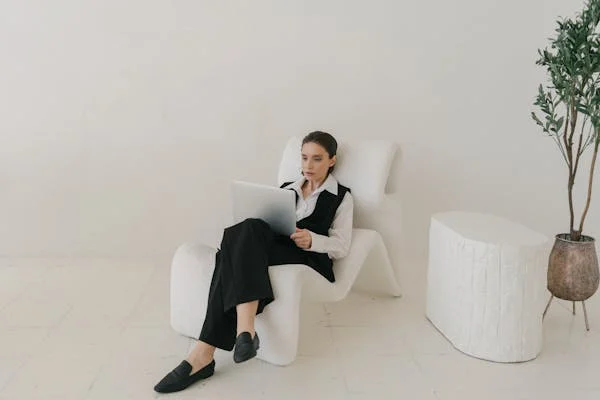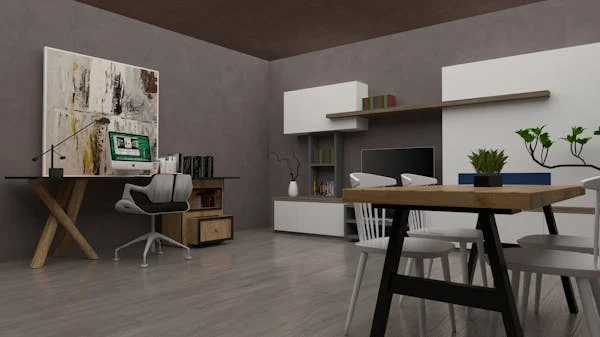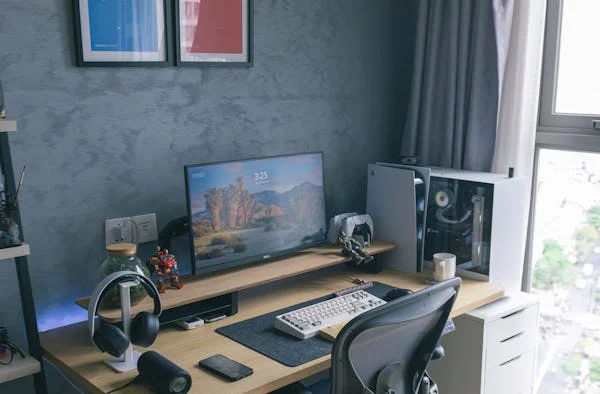Creating an Ultimate Ergonomic Home Office in the US isn’t just a luxury; it’s a necessity for anyone working remotely or navigating hybrid work arrangements. With more people embracing flexible work models, an ergonomic home office has become a cornerstone of health and productivity. This guide will help you transform your workspace into a haven of comfort and efficiency. Whether you’re a freelancer, a remote employee, or someone who simply wants a healthier work environment, these steps will show you how to design the ultimate ergonomic home office to enhance both your well-being and performance.
What is Ergonomics and Why Does It Matter?
Understanding Ergonomics
Ergonomics is the science of optimizing environments to suit the user’s physical needs. When applied to workspaces, it focuses on reducing strain, improving posture, and boosting productivity. For those setting up the Ultimate Ergonomic Home Office in the US, ergonomics is a game-changer. By creating a space tailored to your body’s requirements, you can prevent common work-from-home health issues such as back pain, neck strain, and carpal tunnel syndrome.
Benefits of an Ergonomic Home Office
- Reduced risk of injuries: Proper ergonomics significantly decreases the likelihood of repetitive strain injuries (RSIs) and musculoskeletal disorders.
- Enhanced productivity: A well-designed setup allows you to focus better, work efficiently, and feel less fatigued.
- Long-term savings: While creating the Ultimate Ergonomic Home Office in the US may require an initial investment, it helps avoid long-term healthcare expenses related to poor posture and sedentary habits.
Key Considerations Before Setting Up Your Home Office
Evaluating Your Space
The foundation of the Ultimate Ergonomic Home Office in the US begins with finding the right location. Assess your home for a quiet, well-lit space with minimal distractions. Consider factors like room size, access to natural light, and electrical outlets. Your chosen spot should have enough room for your essential equipment and allow you to move freely.
Setting a Budget
Ergonomic setups can range from affordable to high-end, depending on your preferences. Prioritize key items like a quality ergonomic chair, an adjustable desk, and proper lighting. While it’s tempting to go all-in, starting with essentials ensures you get the most impactful improvements first. Remember, building the Ultimate Ergonomic Home Office in the US is an investment in your health and productivity.
Step 1: Choosing the Right Desk for Your Ultimate Ergonomic Home Office in the US
Features of an Ergonomic Desk
A desk is the centerpiece of your Ultimate Ergonomic Home Office in the US, playing a crucial role in maintaining a comfortable and productive workspace. Here are the must-have features:
- Adjustability: An ergonomic desk should allow you to easily transition between sitting and standing. This sit-stand capability promotes movement, reducing the risks associated with prolonged sitting.
- Spacious surface: Ensure the desk has enough room for your monitor, keyboard, mouse, and additional items like notebooks or a desk lamp.
- Cable management: Built-in cable management systems keep your workspace neat and organized, reducing distractions.
- Durability: Look for desks made of high-quality materials like solid wood or steel to ensure long-lasting use in your Ultimate Ergonomic Home Office in the US.
Desk Placement Tips
- Leverage natural light: Position your desk near a window to make the most of natural sunlight, which enhances mood and reduces eye strain. Avoid placing your screen directly in front of the light source to minimize glare.
- Space for movement: Ensure there is enough clearance around your desk for easy movement and accessibility to office essentials, such as filing cabinets or storage bins.
- Ergonomic alignment: Place your desk at a height where your elbows rest at a 90-degree angle while typing. This alignment prevents unnecessary strain on your wrists and shoulders.
Choosing the right desk is one of the first steps to creating the Ultimate Ergonomic Home Office in the US, ensuring your workspace is both functional and health-focused.
Step 2: Selecting the Ideal Chair for an Ultimate Ergonomic Home Office in the US
Characteristics of an Ergonomic Chair
No Ultimate Ergonomic Home Office in the US is complete without a high-quality ergonomic chair. A proper chair prevents back pain, promotes good posture, and supports long work hours. Key features to prioritize include:
- Lumbar support: Opt for a chair with an adjustable lumbar cushion or built-in support to protect your lower back.
- Height adjustability: Your chair should allow you to adjust the seat height so your feet rest flat on the floor, with your knees bent at a 90-degree angle.
- Tilt mechanism: Reclining options enable you to change positions throughout the day, reducing pressure on your spine.
- Breathable material: Chairs with mesh backrests or high-quality fabric prevent overheating, adding to your comfort.
- Swivel base and wheels: These features allow for smooth movement, making it easier to reach items around your workspace without straining.
How to Adjust Your Chair for Maximum Comfort
Proper adjustments ensure your chair complements the rest of your Ultimate Ergonomic Home Office in the US setup. Follow these steps:
- Seat height: Adjust the chair so your feet are flat on the floor, and your thighs are parallel to the ground. Avoid dangling feet, as this can strain your legs.
- Lumbar support: Align the lumbar support with the natural curve of your lower back to maintain proper posture.
- Seat depth: Ensure there’s a small gap (about 2–3 fingers wide) between the edge of the seat and the back of your knees to promote blood circulation.
- Armrests: Position the armrests so your elbows are at a 90-degree angle, resting comfortably without hunching your shoulders.
- Recline settings: Adjust the tilt mechanism to allow slight backward recline, which reduces spinal pressure while keeping you supported.
By selecting and properly adjusting an ergonomic chair, you’ll eliminate common discomforts and elevate the functionality of your Ultimate Ergonomic Home Office in the US. Pairing this with an ergonomic desk sets the stage for a workspace designed to optimize your health and productivity.

Step 3: Setting Up Your Monitor and Screen for the Ultimate Ergonomic Home Office in the US
Monitor Placement
Achieving optimal monitor placement is vital for reducing neck, shoulder, and eye strain in your Ultimate Ergonomic Home Office in the US. Proper screen positioning allows you to work more comfortably for longer periods. Key guidelines include:
- Height: Position the top of your monitor screen at eye level so that you can gaze at the screen without tilting your head up or down. This minimizes neck strain. A monitor stand or adjustable arm can help achieve this ideal height.
- Distance: Place the monitor about 20–24 inches from your eyes (roughly an arm’s length). This helps reduce eye fatigue from prolonged screen time while maintaining a clear and comfortable view.
- Tilt angle: Tilt the screen slightly backward (about 10–20 degrees) for better posture, as this aligns the screen with your natural eye movement.
- Dual monitors: If you use multiple monitors, position them at the same height and distance to prevent strain on your neck and eyes. Your primary monitor should be directly in front of you, while secondary monitors can be placed slightly to the side. This ensures smooth transitions between screens without excessive head movements.
Step 4: Optimizing Keyboard and Mouse Placement for the Ultimate Ergonomic Home Office in the US
Keyboard Tips
A well-positioned keyboard is crucial to achieving ergonomic success in your Ultimate Ergonomic Home Office in the US. Here’s how to set it up to avoid wrist and arm strain:
- Position: Place the keyboard directly in front of you at elbow height to keep your arms at a 90-degree angle. This ensures that your forearms are parallel to the floor and reduces strain on the shoulders and wrists.
- Angle: Avoid tilting the keyboard upward, as this increases wrist extension, which can lead to strain. Instead, keep the keyboard flat or at a slight negative angle to encourage a neutral wrist position.
- Wrist support: Consider using a padded wrist rest to keep your wrists in a neutral position while typing. This will minimize pressure on the tendons and prevent discomfort during extended typing sessions.
Choosing an Ergonomic Mouse
Selecting the right mouse and positioning it properly will ensure that your Ultimate Ergonomic Home Office in the US minimizes stress on your hands and wrists:
- Ergonomic design: Choose a mouse with a natural, contoured shape that fits comfortably in your hand. An ergonomic mouse, especially a vertical one, can reduce the wrist rotation associated with traditional mice.
- Mouse placement: Keep the mouse as close to your keyboard as possible to avoid stretching and straining your arm and shoulder. The goal is to minimize movement so you can comfortably click and scroll without shifting your posture.
- Additional features: Look for mice with programmable buttons that streamline your work tasks, reducing repetitive motion and enhancing productivity in your Ultimate Ergonomic Home Office in the US.
Step 5: Enhancing Lighting and Minimizing Glare in Your Ultimate Ergonomic Home Office in the US
Lighting Essentials
Proper lighting plays a pivotal role in the comfort and health of your Ultimate Ergonomic Home Office in the US, reducing eye strain and boosting productivity. Here’s how to achieve the perfect balance:
- Natural light: Place your desk near windows to maximize natural light, which has been shown to improve mood and reduce fatigue. Be mindful of direct sunlight, though, as this can create glare on your screen.
- Artificial lighting: Incorporate a combination of soft, adjustable desk lamps and overhead lights to reduce shadows and harsh contrasts. Use warm-toned lights that mimic natural daylight to create a cozy yet functional work environment.
- Task lighting: Invest in a desk lamp with adjustable brightness and direction. The ability to customize the light intensity will help minimize glare from screens while providing sufficient lighting for reading and writing tasks.
How to Reduce Glare
Glare can significantly impact both comfort and productivity in your Ultimate Ergonomic Home Office in the US. Follow these tips to reduce glare and protect your eyes:
- Anti-glare screen protectors: Install these on your monitors to diffuse light and prevent reflections from windows or overhead lights. This helps reduce eye strain caused by screen brightness.
- Screen placement: Position your screen perpendicular to any windows or light sources. Avoid placing your monitor directly in front of a light source, as it will create distracting reflections.
- Window treatments: Install adjustable blinds or curtains to control the amount of sunlight entering your workspace, preventing glare while still allowing natural light.
Step 6: Incorporating Movement into Your Ultimate Ergonomic Home Office in the US
Using Sit-Stand Desks
Movement is a key factor in maintaining an ergonomic setup. A sit-stand desk is an essential tool for the Ultimate Ergonomic Home Office in the US to promote better posture and reduce fatigue:
- Alternating between sitting and standing: Aim to stand for 15–30 minutes every hour to improve circulation and reduce muscle fatigue. Switching positions frequently keeps your body engaged and reduces the risk of developing musculoskeletal problems.
- Budget-friendly solutions: If investing in a full sit-stand desk isn’t feasible, consider a desk converter that allows you to raise your existing desk to a standing height. These converters are typically more affordable and flexible, providing the same ergonomic benefits.
- Anti-fatigue mats: If you stand for prolonged periods, use an anti-fatigue mat to cushion your feet and prevent discomfort. These mats reduce pressure on your legs and lower back while promoting better posture during standing work sessions.
Scheduling Breaks for Optimal Ergonomics
Frequent breaks are vital for both physical health and mental clarity in your Ultimate Ergonomic Home Office in the US:
- Stretching: Set a timer to remind yourself to take short breaks every 30 minutes. Stretch your arms, neck, back, and wrists to alleviate tension from sitting.
- Walks and movement: A brief walk around your home or office space gives your body a break and re-energizes your mind. Even a few minutes of movement can reduce mental fatigue and increase focus.
- Desk exercises: Incorporate simple exercises into your routine, such as seated leg lifts, shoulder rolls, or wrist stretches, to combat stiffness. These activities improve circulation and relieve tension in your muscles.
By following these steps, you can set up the Ultimate Ergonomic Home Office in the US, ensuring comfort, productivity, and long-term health benefits. Each element—from your desk and chair to your monitor setup and movement habits—contributes to a healthier and more efficient work environment.
Step 7: Adding Comfort and Style to Your Ultimate Ergonomic Home Office in the US
Essential Ergonomic Accessories for Your Ultimate Ergonomic Home Office in the US
While having the right furniture and equipment is important, incorporating additional ergonomic accessories can significantly improve your comfort and support during work hours. These accessories are key elements in designing the Ultimate Ergonomic Home Office in the US that enhances both productivity and well-being:
- Footrests: A footrest helps maintain proper posture by keeping your feet flat and supported, especially if your desk height is not adjustable. A footrest can reduce strain on your lower back and legs, promoting better circulation throughout the day. Choose one that is adjustable to accommodate your specific needs, ensuring your feet are at the right angle and your knees remain comfortably bent at a 90-degree angle.
- Wrist Rests: If you spend long hours typing, wrist rests are essential for reducing pressure on your wrists and preventing conditions like carpal tunnel syndrome. A gel or memory foam wrist rest offers soft support that promotes a neutral wrist position while typing or using a mouse. Ensure the rest is positioned at the same level as your keyboard or mouse to maintain optimal wrist alignment.
- Adjustable Monitor Stands or Arms: These accessories are excellent for fine-tuning your screen’s height and angle, ensuring the proper ergonomic setup. A monitor arm allows you to raise and tilt the screen easily, ensuring it is at eye level and reducing neck strain.
Decorating Your Workspace for Comfort and Inspiration in Your Ultimate Ergonomic Home Office in the US
An ergonomic office is not only about function but also about creating an environment that fosters creativity, calm, and comfort. Personalizing your Ultimate Ergonomic Home Office in the US with thoughtful decorations can enhance your mood and overall well-being while boosting productivity. Here’s how to make your workspace both stylish and functional:
- Incorporating Plants: Adding greenery to your workspace improves air quality and adds a calming aesthetic to your office. Plants like succulents or small potted plants on your desk can reduce stress and create a pleasant environment. Studies have shown that indoor plants can also improve focus and productivity by reducing fatigue and improving the atmosphere of your workspace.
- Artwork and Personal Touches: Surrounding yourself with artwork, inspiring quotes, or personal mementos can boost morale and make your home office feel like a space you enjoy spending time in. Displaying artwork with soothing colors or motivational messages can reduce stress and add a sense of purpose to your workday.
- Calming Colors: Choose a color palette that promotes focus and relaxation. Neutral tones like light grays, blues, and soft greens are ideal for creating a peaceful atmosphere. Avoid overly bright or stimulating colors, which could disrupt your focus. Consider painting the walls or adding accessories that complement the colors of your workspace, such as a comfortable chair cushion or a decorative rug.
By adding these small but impactful touches to your Ultimate Ergonomic Home Office in the US, you create a harmonious space that balances comfort, style, and functionality. A well-decorated office not only supports your physical health but also nurtures mental well-being, encouraging long hours of productive and enjoyable work.

Conclusion:Your Path to a Healthier Workspace
Designing the Ultimate Ergonomic Home Office in the US is crucial for boosting comfort and productivity. By selecting the right desk, chair, and accessories, and adjusting them to fit your body’s needs, you can prevent strain and enhance focus. Simple changes like proper lighting, ergonomic positioning, and regular movement can have a significant impact on your well-being.
Start making adjustments today to transform your workspace into a healthier, more productive environment. The benefits—better posture, reduced pain, and increased efficiency—will positively affect both your work and your health.
You can also read more tips on creating ergonomic setups for different work styles at Laptop-Friendly Ergonomic Setups.
FAQ Section
1. What is the ideal desk height for an ergonomic setup?
Your desk should be at elbow height when you’re seated, allowing your arms to form a 90-degree angle.
2. Can I achieve an ergonomic setup on a budget?
Yes! Prioritize essentials like an adjustable chair and proper lighting. Many affordable options are available online.
3. How often should I take breaks?
Take short breaks every 30 minutes and longer ones every 1–2 hours to stretch and rest your eyes.
4. Are standing desks better than sitting desks?
Standing desks promote movement but aren’t inherently better. Alternating between sitting and standing is key.
5. Do I need an ergonomic keyboard?
Not necessarily, but an ergonomic keyboard can reduce wrist strain, especially for long typing sessions.
6. What’s the best way to improve lighting in my home office?
Use a mix of natural light and adjustable desk lamps with warm-toned bulbs.
7. How do I maintain good posture while working?
Keep your back straight, shoulders relaxed, and feet flat on the floor. Adjust your chair and desk to support this posture.
8. Can plants improve my workspace?
Yes! Plants improve air quality and create a calming atmosphere, boosting productivity and mood.


